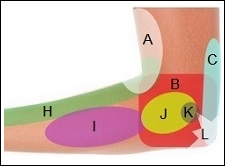- Home
- Elbow Pain Diagnosis
- Outer Elbow Pain
Pain On Outside Of Elbow
Written By: Chloe Wilson BSc (Hons) Physiotherapy
Reviewed By: SPE Medical Review Board
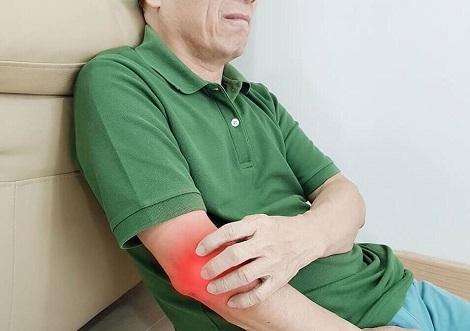
Pain on the outside of the elbow is a common problem.
Outside elbow pain, aka lateral elbow pain, is typically an overuse injury, although can occur from a specific trauma e.g. a fall onto the elbow.
Outer elbow pain may be localised or may spread further down the forearm.
The most common cause of pain on the outer side of the elbow is lateral epicondylitis, aka Tennis Elbow, but there are lots of other possibilities as well.
There is often tenderness, swelling and stiffness and it can affect hand function and grip strength.
Here we will look at the most common causes of pain on the outside of the elbow, what causes them, typical symptoms and the best treatment options for each. If your pain is more around the back of your elbow, check out the posterior elbow pain article or if it is further down your arm, check out the forearm pain section.
What Causes Outside Elbow Pain?
Common causes of pain on the outside of the elbow are:
1. Tennis Elbow
The most common cause of outer elbow pain is Tennis Elbow, aka lateral epicondylitis.
Tennis elbow is an overuse injury which causes inflammation and tearing of the common extensor tendon of the forearm muscles leading on outside elbow pain.
Tennis elbow doesn’t just affect sports players, it’s just as likely to affect office workers or manual workers.
Common symptoms of lateral epicondylitis include pain on outside of elbow, forearm weakness, decreased grip strength and pain with any twisting or gripping activities e.g. opening a jar or holding a mug. There are four stages of tennis elbow with gradually worsening symptoms at each stage.
Treatment for tennis elbow focuses initially on reducing pain on outside of elbow and inflammation and then aims to improve the strength and flexibility around the outer elbow so you can return to your activities without the outside elbow pain returning.
You can find out loads more about the causes, symptoms, diagnosis and treatment options in the Tennis Elbow Section.
2. Radial Tunnel Syndrome
Another possible cause of outside elbow pain is radial tunnel syndrome, aka radial nerve entrapment.
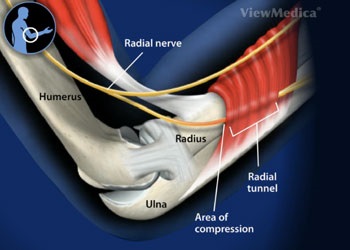
Radial tunnel syndrome develops when there is compression of one of the nerves in the forearm, just below the elbow.
This is usually from repetitive forearm movements such as gripping, twisting and throwing activities and is common in sports and manual labor.
Radial tunnel syndrome typically affects people aged 30-50 years old and is more common in women than men.
Common symptoms of radial tunnel syndrome are a burning pain on the outside of the elbow, usually around 3cm below the joint. The outside elbow pain usually gets worse with any forearm work and can lead to weakness in the wrist and hand.
You can find out more about outer elbow pain from radial tunnel syndrome including the causes, symptoms, diagnosis and treatment options in the Radial Tunnel Syndrome section.
3. Radiohumeral Bursitis
Radiaohumeral bursitis is inflammation of the radiohumeral bursa, a small fluid-filled sac on the outer elbow. Bursa sit between bones and soft tissues to reduce the friction between structures during movements.
Inflammation of the radiohumeral bursa may be caused by a direct blow to the outer elbow, repetitive forearm movements, infection or an underlying medical conditions e.g. gout or arthritis. These irritate the bursa causing it to produce excess fluid in an attempt to protect the elbow from further damage which pools in the sac.
Radiohumeral bursitis causes outside elbow pain and inflammation, may limit elbow movement and may be accompanied by visible/palpable localised swelling.
Outer elbow pain from bursitis is usually treated with a combination of rest, ice, medication and steroid injections.
4. Osteochondritis Dissecans
Osteochondritis Dissecans (OCD) is the most common cause of pain on outside of elbow in young athletes.
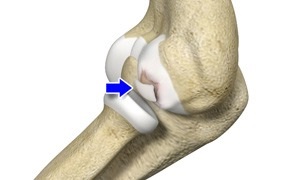
OCD is caused by repetitive overhead motion e.g. baseball, gymnastics and weightlifting.
Damage to the bone and cartilage on the outer elbow from reduced blood flow to the area causes fragments to break off which may get stuck in the joint.
Treatment for elbow osteochondritis dissecans aims to reduce outer elbow pain through a combination of rest, elbow bracing, physical therapy and in some cases surgery. Osteochondritis can develop in any joint but is particularly common in the knee, hip and elbow.
5. Elbow Synovitis
With elbow synovitis there is inflammation of the synovial membrane, the connective tissue that lines the elbow joint.
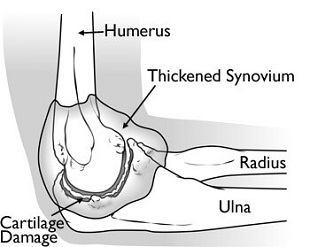
Synovitis is typically caused by overuse and is common in people whose jobs/hobbies involve repetitive elbow or forearm movements.
It can also be caused by infection, injury e.g. direct blow to the elbow, or underlying medical conditions e.g. arthritis or gout.
In some cases there may also be irritation and inflammation of the plica – small folds in the synovium, known as elbow plica syndrome. Symptoms of synovitis are usually short lived and may include localised pain on outside of elbow, swelling, stiffness and warmth.
The best way to treat outer elbow pain from synovitis is with rest, anti-inflammatory medications, wearing an elbow brace and in some cases steroid injections.
6. Elbow Fractures
Elbow fractures can also cause outer elbow pain, usually from a sudden injury e.g. a fall onto the elbow, or twisting injury. There may be a snapping or popping sound or sensation at the time of injury followed by elbow pain, swelling and loss of movement. There may also be an obvious deformity if the bones are displaced (have moved out of place).
The three most common types of elbow fracture are:
- Radial Head & Neck Fractures: a break at the top of the radius - the forearm bone that runs between the elbow and the wrist (thumb side). Causes pain on outside of elbow that gets worse with forearm rotation
- Distal Humerus Fractures: a break at the bottom of the humerus – the upper arm bones that runs between the shoulder and the elbow
- Olecranon Fractures: A break at the top of the ulna, the pointy part at the back of your elbow. Often associated with elbow dislocations
Treatment for elbow fractures will depend on the location and severity of the injury. Simple elbow fractures can often be treated with immobilisation in a sling, brace or cast. More complex elbow fractures often require surgery using screws, plates or pins to reattach and realign the broken fragments of bone, particularly if they are displaced.
Pain On Outside Of Elbow Summary
- The most common cause of pain on the outside of the elbow is Tennis Elbow
- Other possible causes of outer elbow pain include radial tunnel syndrome, radiohumeral bursitis, osteochondritis dissecans, synovitis and elbow fractures
- Most cases of outer elbow pain are due to repetitive overuse of the forearm muscles from sports, manual labor, gripping and typing.
- Pain may extend down the arm including forearm pain and hand weakness
- The earlier you start treatment for outside elbow pain, the quicker recovery is likely to be
- Treatment for lateral elbow pain usually involves a combination of rest, ice, medications, an elbow brace/strap, injections, exercises and occasionally surgery
You may also be interested in the following articles:
Page Last Updated: 03/12/2024
Next Review Due: 03/12/2026

